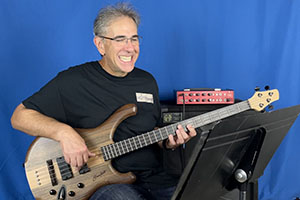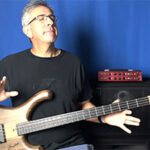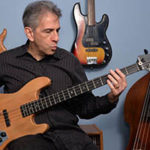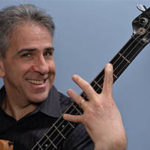Great advice from a classic rocker!
By Jon Liebman
Week of August 16, 2021
It doesn’t matter how old you are or how long you’ve been playing bass. We’re all still learning bass and we all still need to practice.
So when you’re putting in your time in the woodshed, do you feel as though you’ve “got to” practice? Or do you look forward to it, feeling happy that you “get to” practice?
I had a very enjoyable conversation recently with Stanley Sheldon, published as this week’s FBPO interview. Stan, of course, is the bassist on one of the most iconic albums in rock history, Frampton Comes Alive!
In addition to having played with Peter Frampton, Stan has also worked with everyone from Tommy Bolin and Warren Zevon to Delbert McClinton and Cheech & Chong.
So after having done all that, does Stan still (have to) practice? You bet he does!
When I asked Stan what advice he had for someone who wants to learn bass, he jumped right into the “practice” mindset, with some great tips for making practicing a truly enjoyable experience.
“Find a way to frame your practice sessions so that it’s so much fun for you that you just get lost in it,” Stan says. “And the way I’ve always done it,” he says, “is to put on the headphones or just sit in front of really good speakers with my favorite music and my favorite bass players. And I just sit there and I dig in.”
Granted, when it comes to practicing, playing along with records is nothing new. Maybe you’ve even done it yourself.
But in Stan’s case, he goes all out.
“I get the level just right where I can superimpose myself right over the track,” he continues. “And then I’m playing with the greatest musicians in the world.”
This approach adds another dimension to practicing. In playing along with records, I always did it with the mindset of listening to how other people play, learning what they’re doing, and then trying to improve my own playing.
Just think how much fun Stan’s way would be. I mean, imagine yourself actually playing with… Miles Davis, or the Beatles, or… Peter Frampton!
“That’s how I still practice today,” Stan says.
And what about when you come to that passage, that interlude, that tricky part in the song that’s out of your comfort zone?
“Just keep stopping it and learning and going over the same passage a hundred times, 200 times if that’s what it takes,” advises Stan. “That’s what I do.”
So go ahead and practice your scales, your modes, your etudes, or whatever’s on your agenda. But always keep in mind the reason you need to be able to play those things. At the end of the day, it’s about making music. Why not join your favorite band? There’s nothing stopping you. And you’ll be so glad you “get to” practice with them.
How about you? Have a thought on the subject? Leave a comment below and let me know what you think. In the meantime, check out my interview with Stanley here.






This is, by far, one of my favorite articles by you Jon (and there are many BTW!)
I couldn’t agree more. At the end of the day, it comes down to playing music with other musicians. Even if your practice sessions are with “virtual” musicians, a tremendous benefit to playing along with records can be obtained if you do it as part of your regular practice routine. This goes with any and all styles of music. I do this on a daily basis (especially now with live music being in a temporary slump). Even classical music. There’s a great website called the IMSLP that has thousands of orchestra parts in pdf form. I’ll print off the double bass part to whatever symphony or work that I want to learn/practice and purchase an mp3 of the piece and play along. It’s great practice for sight reading, intonation, bow articulation…etc. I do the same thing for literally every style of music that I want to become more involved in and have a deeper understanding of. Thanks so much for posting this interview Jon. Hope you’re well.